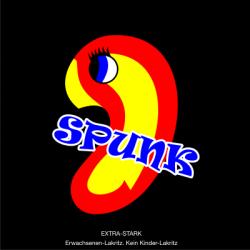Aðfangadagur
(Ath-founga-dager)
December 24th, Aðfangadagur, is the day Icelanders celebrate Christmas (as opposed to December 25th in most countries). The first half of the day usually goes towards finishing off all of the last minute preparations, making food, wrapping presents, bathing and putting on nice clothes. Children are often occupied by the television set, as most stations broadcast a non-stop programme of cartoons through the day.
Six o’ clock marks the official start of Christmas in Iceland (see our guide to conducting Icelandic Christmas for more info on why that is), and this is when most households sit down to enjoy a pleasant holiday meal. After dinner, most people commence opening their presents. They then hang out and indulge until bedtime.
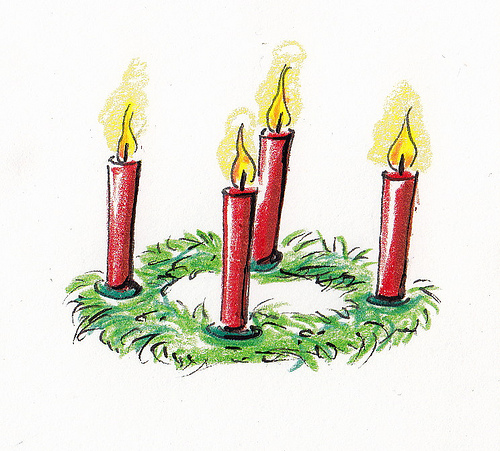 Aðventa
Aðventa
(Ath-venta)
Aðventan, or the Advent, is the month leading up to Christmas. Icelanders celebrate each Sunday of the Advent (starting on the fourth Sunday prior to Christmas) by lighting candles on an Advent Wreath (“Aðventukrans”), which is usually a four-candle (one for each Sunday of the Advent) evergreen wreath. The first Sunday of Advent marks the time most Icelanders start decorating for the holidays and preparing in general.
Aðventukrans
(Ath-ventou-kraans)
See: Aðventa.
Aðventuljós
(Ath-ventou-lyows)
Aðventuljós, or Advent light, is a decorative object somewhat unique to Iceland. This seven-armed electric candlestick is found in at least one window of almost every Icelandic home throughout the holiday season. See our Xmas guide for more info.
Annar í jólum
(Aann-arr ee yo!-luwm)
December 26th, the second day of Christmas, is the designated party day of the holiday season (New Year’s notwithstanding). The day itself usually entails heavy lounging and attending a family Christmas party or two, but the evening has most of the action, with bars and clubs opening for business around midnight. Revellers like to go out at that time, decked in their fancy holiday attire and re-connecting with friends and acquaintances that they haven’t seen for all of three days.
Áramót
(our-a-mowt)
See: Gamlársdagur/Gamlárskvöld.
Áramótaannáll
(our-a-mowt-a-annoudl)
Icelanders are fond of watching television on New Year’s Eve, with most of the day’s programming dedicated to detailing the fast fading year’s events. Second to the Áramótaskaup in popularity is the Áramótaannáll on RÚV, a collage of the year’s TV news stories with commentary from the news team. An international version and a local one run back to back. Check newspapers’ TV listings for more info.
Áramótaskaupið
(our-a-mowt-a-skoj-pith)
Gathering around the TV on New Year’s Eve to watch the Áramótaskaup comedy special on RÚV is an old and honoured Icelandic tradition—in fact the streets fall completely silent during its broadcast time of 22:30-23:30. The show itself is a comedy revue featuring many of Iceland’s best-loved actors that parodies the year’s events in sketches and song. The quality differs from year to year, but Icelanders love even the especially bad ones (because then they can complain to each other about how much it sucked). It is not subtitled, so the fun is likely lost on non-Icelandic speakers. It’s worth checking out, though, you can always make fun of Icelandic TV’s low production standards.
Attire
Icelanders like to dress smart and snazzy over the holidays. Formal attire is usually expected in the parties of the 24th and 25th, on other days go for neat casual outfits.
Christmas music
Iceland doesn’t have a lot of original Xmas songs, although there are a few to be found. Mostly the tunes meant to get you into the holiday spirit are translations of international Xmas ones (some of them don’t have anything whatsoever to do with Xmas), so the stuff blaring from the radio in the knick-knack shop should sound familiar. There are some popular local songs, however, the most infamous one being Sniglabandið’s Jólahjól (“Christmas bike”). For more on Icelandic Xmas music, read Dr. Gunni’s column about it here.
Christmas stockings
See also: Jólasveinar, Santa Claus
The Christmas stockings tradition is celebrated in Iceland, although it differs greatly from what you might be used to. As explained elsewhere, there are thirteen Yuletide lads in Iceland, and each one comes down from the mountains on a designated day before Christmas bearing gifts for children to be placed in their shoe or stocking left by an open window. It should be noted that well-behaved children receive something of value, whereas ill behaved children usually receive a rotten potato.
Commerce
See also: Þorláksmessa
Like elsewhere, Christmas and commerce have very close ties in Iceland. Stores stay open until 11 PM on Þorláksmessa, the 23rd of December, and until noon on the day of Christmas Eve. This is done in a mutual agreement between late shoppers and greedy shop owners who want to make sure that no Króna is left behind.
Dancing
See also: Jólaboð, jólaball, jólatré
Dancing around the Christmas tree is still a widespread fad at Christmas dances in schools around the country, but the tradition is slowly dying out as a practice in homes. It involves holding hands around the tree and walking repeatedly in circles whilst singing Christmas carols. Hours of fun.
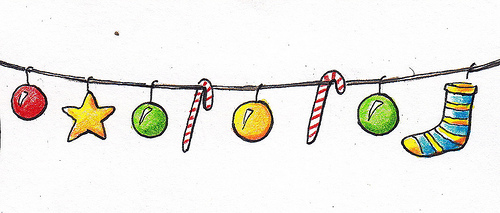 Decorating
Decorating
See also: Aðventa, Aðventuljós
Icelanders like to decorate their houses a lot in time for Christmas, with the start of Advent usually marking the official ‘OK time’ for decking the halls. Decorations are similar to what may be found in the rest of the Christmas-celebrating world: pine branches, light sets, Santa-related effigies and various knick-knacks and doodads. American style lighting monstrosities are uncommon, but not unheard of.
Drinking
See also: Annar í jólum, Gamlársdagur/Gamlárskvöld
Heavy drinking is generally not condoned on Christmas Eve or Christmas Day—although indulging in a glass of wine or two isn’t frowned upon—as the days’ festivities are generally reserved for family activities. The 26th, 31st and New Year’s Day are popular for binge drinking and partying, however, as are any weekend days that fall between the two days.
Eating out
See also: Christmas buffets, commerce
Icelanders generally don’t like to eat out during the holiday season. If you are visiting, and you plan on dining at a restaurant during the holidays (see our special Xmas listings for details), chances are you’ll be dining with some fellow tourists. However, attending special Xmas buffets is a popular activity over the advent.
Family
Icelandic Christmas is all about one’s family, extended and otherwise. Generally speaking, most Icelanders will be busy spending time with their families from December 24th until the eve of the 26th, so don’t expect that hot boy (or girl) you hook up with on the 23rd to be available for any immediate follow-up sessions (you should still try, though).

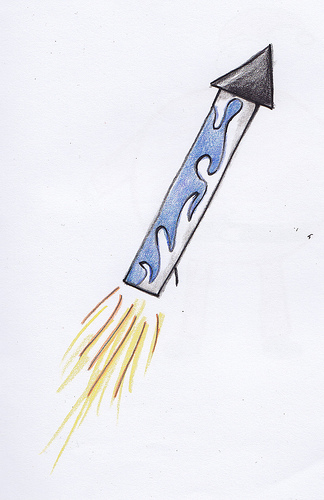 Flugeldar
Flugeldar
(flug-oeld-arrrrr)
See also: Gamlársdagur/Gamlárskvöld
Flugeldar (“fireworks”) are an essential part of the Icelandic New Year’s Eve experience, in fact, the sale and deployment of fireworks is only legal in Iceland between December 28—January 6. Like everything else Icelanders are fond of, they take their fireworks seriously—most of those who have witnessed the mass employment of fireworks at New Year’s will agree that the act is far beyond over-the-top. But most will also attest that the display is striking and beautiful. An added bonus is that most of the places selling them are doing so for charity, or to fund rescue teams.
Expect small blasts here and there as of December 27th, culminating in an all-out orgy of explosions around midnight of New Year’s Eve.
Gamlársdagur/Gamlárskvöld
(gaaml-ouwrs-daager / kvoeld)
See also: Fireworks, drinking, Áramótaskaup, Áramótaannáll, Áramótabrenna [Note: Gamlársdagur refers to New Year’s Eve’s Day, and Gamlárskvöld refers to New Year’s Eve itself]
The coming of the New Year is celebrated pretty heavily in Iceland. Drinks are drunk, fireworks are lit and vomit is, eventually, spewed. Although there is no rule, most folks like to gather for a nice dinner feast with family and/or friends at the start of the evening (or late in the afternoon). They hang out, drink drinks, play board games and watch the TV recap of the preceding year. Many head out to their local New Year’s bonfire, a complete list of which is published in local newspapers on the days leading up to the 31st.
After watching the Áramótaskaup comedy revue and lighting some fireworks, most will head to a rowdier, less family oriented gathering and stay there ‘til dawn.
A note about the word “áramót”: like many Icelandic words, it is impressively and descriptively sensible, and it does not have a counterpart in the English language. Quite literally, “áramót” translates as “the meeting of years”. Makes sense, doesn’t it?
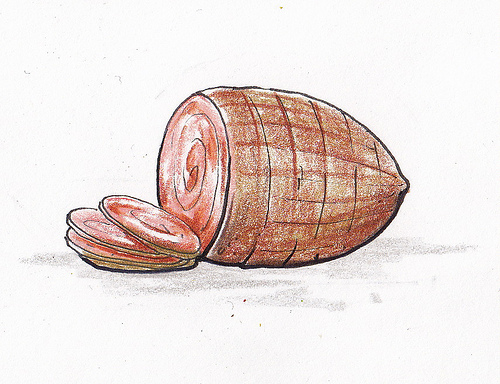 Hangikjöt
Hangikjöt
(Hownge-kjoet)
See also: Jólamatur
Hangikjöt—literally meaning “hung meat”—is smoked Icelandic lamb which takes its name from the old tradition of smoking food in order to preserve it by hanging it from the rafters of a smoking shed. Hangikjöt is traditional Christmas meat, often served with potatoes in a sweet white sauce and pickled red cabbage. It’s pretty awesome.
Hamborgarhryggur
(Haam-bouwrger-hreggurrrr)
See also: Dining
A traditional Christmas food eaten on the 24th at six o’clock. It is pork, usually with a honey glazing and pineapple, cooked in an oven for a few hours. This is a pretty heavy meal, resulting in the number of heart attacks increasing around Xmas when people who really shouldn’t eat fatty meat gorge themselves almost to death.
Heitt súkkulaði
(hate sooqou-laethi)
Indulging in a cup of freshly made heitt súkkulaði (“hot chocolate”) is an essential part of the Icelandic holiday experience. The classic recipe is thus: melt one plate of ‘Suðusúkkulaði’ (available everywhere one might buy chocolate) in a double boiler with 1–2 cups of water. In a separate container, heat one litre of milk to the boiling point. Slowly stir melted chocolate into boiling milk. Enjoy.
Jólaball
(yo!-la-boll)
See also: Jólaboð
The jólaball, or Christmas dance, is a longstanding tradition where children are herded by their parents or schools to hang out, eat cake and candy and dance around a decorated tree while singing some classic Christmas tunes. More often than not, one or more of the Yule lads will make an appearance and disburse small gifts of candies.
Jólaboð
(yo!-la-boeth)
The Icelandic Xmas party—jólaboð—is traditionally a family gathering that involves copious amounts of eating Christmas fare such as hangikjöt and cookies, drinking coffee and chocolate, talking about the weather and engaging in the latest board games (although Trivial Pursuit is always a classic).
Jóladagatal
(yo!-la-dae-ga-tael)
The jóladagatal (“Christmas calendar”) is used to count down the days from December 1st until the 24th and is a must for children of all ages—some adults like to indulge as well. The most common variety has a differently shaped piece of chocolate for each day, although some of the crappier ones just have dumb, holiday related pictures. Some families like to craft their own, wrapping small gifts for each day.
Jóladagur
(yo!-la-daguer)
See also: Jólaboð
Jóladagur—Christmas Day—is the big day for family gatherings and Christmas parties. Many like to sleep in and relax before putting on formal attire and heading out to a friend’s house to indulge in some hangikjöt or hot chocolate. Everything is closed. A very relaxed day, for most.
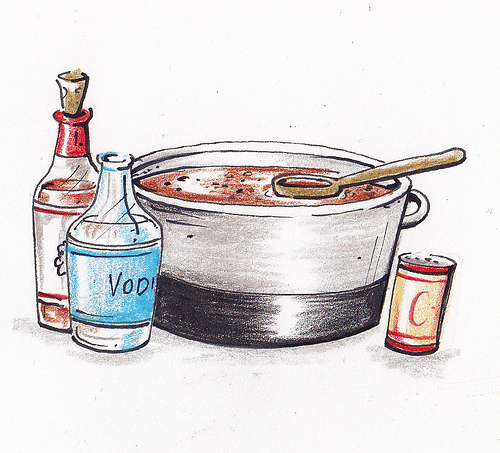 Jólaglögg
Jólaglögg
(yo!-la-gludge)
See also: Jólahlaðborð, drinking
A hot beverage consisting of red wine, vodka, and spices. Often served with raisins. The word can also just mean a party of friends around Christmas time who get together under the pretext that they will drink Jólaglögg, when all they really want to do is drink anything with alcohol in it. You know, because of the dark.
Jólahlaðborð
(yo!-la-hlaeth-boerth)
See also: Christmas dining, eating out, Hamborgarhryggur
A fairly new tradition in Iceland, connected to the number of restaurants increasing in later years. A Jólahlaðborð is a Christmas buffet that people attend in groups, usually co-workers go together for a night of eating, but mostly drinking. Many a marriage has been put to a serious strain after a drunken night at a Jólahlaðborð. Something about Christmas brings out the adulterers in some people.
Jólakort
(yo!-la-kowrt)
Many Icelanders choose to parlay greetings to their friends and loved ones over the holidays via the mailing of Christmas cards, or jólakort. They will most often feature a generic Christmassy motif and some standard well wishes, although some use the opportunities to send along pictures of the family.
 Jólakötturinn
Jólakötturinn
(yo!-la-koett-ur-enn)
To avoid, as the saying goes, “going to the Christmas cat,” children are required to receive at least one piece of new clothing in time for Christmas each year. Otherwise, the cat will eat them.
Jólamatur
(yo!-la-maw-tuer)
See also: Christmas buffets, rjúpur, kæst skata, hangikjöt, jólaöl, jólasmákökur
Like in most other places, nourishing oneself over the holidays is all about indulgence. When it comes to jólamatur (“Christmas food”): the richer, sweeter, fattier and saltier, the better.
 Jólaöl
Jólaöl
(yo!-la-oel)
See also: Christmas dining
The ultimate Christmas drink, Jólaöl (or: “Christmas ale”) is created by mixing an elusive ratio of Malt and Appelsín orange soda. Although you can now buy this drink premixed, but it’s just as fun to mix it yourself, according to taste. Note that it contains no alcohol. Which is nice for a change).
Jólasmákökur
(yo!-la-smouw-koek-er)
See also: Dining
Jólasmákökur (“Christmas cookies”) are an essential part of the Icelandic holiday experience. Most households bake their own cookies in the weeks leading up to Christmas, making an average of 3–5 different types. They are then consumed at Christmas gatherings or while lounging about with ones new presents. Some classic types include: Piparkökur (ginger snaps”), Mömmukökur (ginger snap-type cookies sandwiched around white frosting), súkkulaðibitakökur (chocolate chip cookies) and hálfmánar (rhubarb preserves wrapped in dough), although the varieties are endless.
Jólatré
(yo!-la-tr-yeah!)
See also: Þorláksmessa, Christmas presents
Icelanders’ Christmas trees are usually installed on December 23rd, with the actual decorating taking place on the 24th (although this does differ between households). Various organisations, such as the local rescue squads, sell live trees to fund their operations, although private companies also partake. Fake plastic trees aren’t very popular, although some folks prefer them.
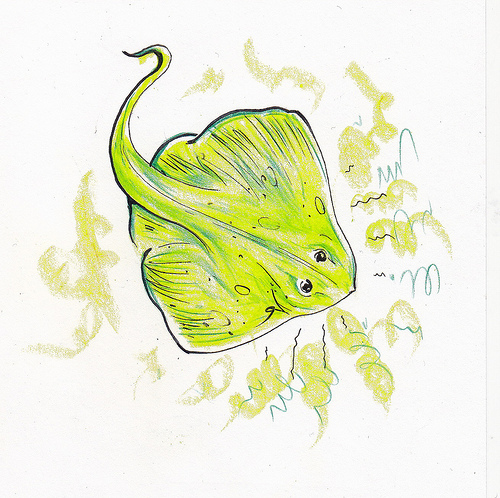
Kæst skata
(kjae-st skaaa-taaaa)
See also: Þorláksmessa
The consumption of kæst skata, or rotted skate, on the 23rd of December is a holiday tradition derived from the West Fjords of Iceland. The dish—which many swear by, and others find especially foul—is most often imbibed at special skate gatherings around noon on the 23rd, and is often served along with potatoes, butter, rye bread and shots of brennivín (most West Fjords experts recommend drinking milk with the skate, as the fish is “intoxicating in and of itself”).
The skate is a chondrichyte, and therefore ferments when allowed to rot, as its urine is distributed through its flesh and goes through a chemical change over time. They are in fact poisonous if eaten before the fermentation process is complete. It is fermented by throwing it in a box and letting it lie for three weeks.
Laufabrauð
(loi-fa-brau-eth)
See also: Aðventan
The making of laufabrauð, or “leaf-bread,” is usually a family-affair taking place early in December. People gather together to cut intricate patterns into this deep-fried, thin flatbread, which is then enjoyed as a tasty snack to accompany any Christmas event or meal. It goes exceedingly well with butter.
Nýársdagur
(knee-ouwrs-da-guer)
See also: Drinking
Icelanders like to spend most of New Year’s Day feeling hung-over and sorry for themselves. As the evening approaches, many will start pulling themselves together and dressing up for New Year’s Day banquets or parties that have grown popular lately. Others will stay in watching DVDs and complaining.
Opening hours
See also: Commerce, eating out
If you are touring in Iceland for the holiday season, we can only hope someone told you of Iceland’s antiquated opening hours for that time. You will not have much luck locating open restaurants—or open anything-else —during Christmas or on New Year’s. Check out our holiday listings guide for info on places that are actually open and happy to serve you.
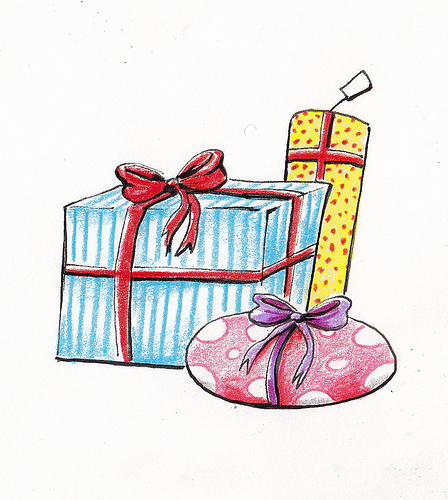 Presents
Presents
See also: Commerce, Aðfangadagur, jólatré
Of course Xmas is all about the presents, and a lot of debt is incurred during the season, even though we’ve yet to discern completely how the act of spreading goodwill through gifts is affected by the full impact of the Kreppa. There are no specific guidelines for Xmas gift giving in Iceland, but a good rule of thumb is to avoid being extravagant in your gift choices, unless maybe something extravagant is called for or expected on the other end.
Generally most folks tend to stick with bestowing presents upon their immediate family and loved ones, although some like to spread the joy to their entire group of friends. In any case, there’s nothing wrong with asking. Xmas presents are stored under the Xmas tree until they’re due to be opened.
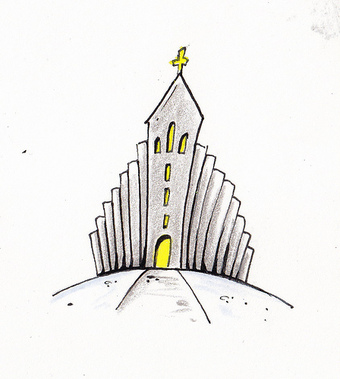 Religion and church
Religion and church
Even though around 80% of them are enrolled in the State Church, Icelanders have never been known to be particularly enthusiastic churchgoers or observers of religious customs. Indeed, Christmas isn’t a particularly religious holiday in Iceland. However, many folks like to attend Church services and concerts during the holidays, particularly on the 24th and the 31st. Check with your tourist information centre for complete church listings.
The ringing of the church bells of Reykjavík’s Lutheran Cathedral is broadcast on all major television and radio stations throughout the country promptly at 18:00 on Christmas Eve, at which point everyone wishes each other a Merry Christmas and sits down to eat.
Returning gifts
See also: Commerce
Exchanging one’s Xmas gifts in lieu of something more desirable is a common practice in Iceland. Most stores will accept returns until the second week of January, although policies differ.
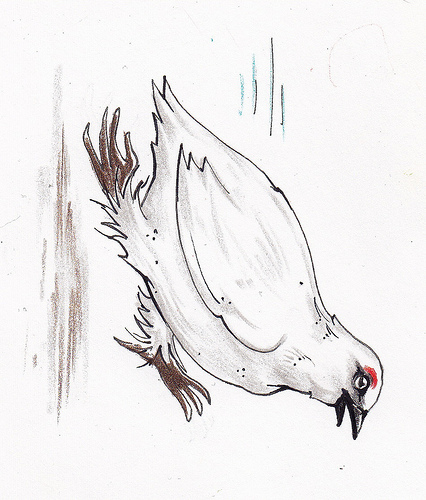 Rjúpur
Rjúpur
(ryooe-purr)
See also: Jólamatur
Wild fowl rjúpur, or ptarmigan, are a popular main course for many families Christmas meals. The small birds can be delicious if handled properly, and have a rich, gamey sort of taste. The Grapevine recommends trying some if you have the chance.
Santa Claus
See also: Jólasveinar
We have no need for your international big, fat, jolly, capitalist greed-mongering Coca Cola Santa Claus in Iceland, as we have thirteen of our own that are much cooler. He still makes an appearance from time to time. Oh we like him fine enough, he’s a jolly good fellow and all.
Vacations
Icelanders usually take pretty hefty Xmas vacations, with December 24, 25 and 26 all being legal holidays, as well as December 31st and January 1st. A lot of folks actually take Dec 23–Jan 2 off entirely—so don’t expect a lot to get done during the Xmas season.
Þorláksmessa
(thoer-louwks-mess-a)
See also: Kæst skata, commerce
In celebration of one of only two Icelandic saints, St. Þorlákur, Icelanders eat fermented skate, which preferably is swallowed with copious amounts of Icelandic Brennivín schnapps. Then, they will traditionally gather on the shopping street Laugavegur to do some last minute shopping (although some do the bulk of their shopping on that day), drink Christmas beer or hot chocolate and have a merry ol’ time. Also, this is traditionally the day that children are allowed to decorate the Christmas tree.
Þrettándinn
(thu-rhett-ouwn-din-n)
January 6 is Þrettándinn (“the thirteenth”), the thirteenth and final day of Christmas according to Icelandic tradition. The event is celebrated with torch processions, bonfires, fireworks, and the king and queen of the hidden people traditionally join the festivities. Back in olden times, it was a scary time to be out and about, as the hidden people can be surprisingly sinister.
Jólasveinar
(yo!-la-svain-er)
See also: Christmas stockings, Santa Claus
The Icelandic Jólasveinar (Yule Lads) have little to do with the international Santa Claus. They are descended from trolls, and were originally bogeymen used to scare children. During this century they have mellowed, and sometimes don red suits. Their number varied in old times from one region of Iceland to another. The number thirteen is first seen in a poem about Grýla (the Lads’ mother) in the 18th century, and their names were published by Jón Árnason in his folklore collection in 1862. About 60 different names of Yuletide Lads are known. They visit the National Museum on each of the 13 days before Christmas.
On December 12 the Yuletide Lads begin to come to town. The first is Stekkjastaur (Sheepfold Stick), who would try to drink the milk from the farmers’ ewes.
On December 13 Giljagaur (Gully Oaf) arrives. Before the days of milking machines, he would sneak into the cowshed and skim the froth off the pails of milk.
The Lad who arrives on December 14 is Stúfur (Shorty) who, as his name implies, is on the small side. He was also known as Pönnuskefill (pan-scraper), as he scraped scraps of food off the pans.
On December 15, Þvörusleikir (Spoon-licker) comes down from the mountains. He would steal the wooden spoon that had been used for stirring. When he visits the National Museum, he goes looking for wooden spoons.
On December 16, Pottasleikir (Pot-licker) comes visiting. He tried to snatch pots that had not been washed, and lick the scraps from them.
Askasleikir (Bowl-licker) arrives on December 17. He hid under beds and if someone put his wooden food-bowl in the floor, he grabbed it and licked it clean.
Hurðaskellir (Door-slammer) comes on December 18. He is an awfully noisy fellow, who is always slamming doors and keeping people awake.
The Lad who is expected on December 19 is called Skyrgámur (Curd Glutton), because he loves skyr (milk curd) so much that he sneaks into the pantry and gobbles up all the skyr from the tub there.
Bjúgnakrækir (Sausage Pilferer) comes on December 20. He loves sausages of all kinds, and steals them whenever he can.
On December 21, Gluggagægir (Peeper) arrives. He is not as greedy as some of his brothers, but awfully nosy, peeping through windows and even stealing toys he likes the look of.
On December 22 Gáttaþefur (Sniffer) comes calling. He has a big nose, and he loves the smell of cakes being baked for Christmas. He often tries to snatch a cake or two for himself.
December 22 was sometimes called hlakkandi (looking forward), because the children had started looking forward to Christmas.
On 23 December, St. Þorlákur’s Day, Ketkrókur (Meat Hook) arrives. He adores all meat. In olden days he would lower a hook down the kitchen chimney and pull up a leg of lamb hanging from a rafter, or a bit of smoked lamb from a pan, as smoked lamb was traditionally cooked on St. Þorlákur’s Day.
Kertasníkir (Candle Beggar) comes on Christmas Eve, December 24. In olden times, candlelight was the brightest light available. Candles were so rare and precious that it was a treat for children to be given a candle at Christmas. And poor Candle Beggar wanted one too.
During the thirteen days before Christmas, the National Museum presents actors dressed as the old-school Jólasveinar. They show up around 11 AM each day. National Museum, Suðurgata 41, 101 Reykjavík. Tel. 530 2200.
Santa Claus write-up By Paul F Nikolov. Originally appeared in issue 16/200
Buy subscriptions, t-shirts and more from our shop right here!

